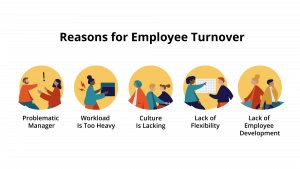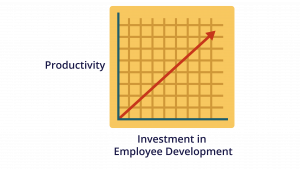13.2 The Business Case for Employee Development
As an Operations Manager, you will need to invest time, money and effort into developing existing employees in preparation for future roles and the growth of your organization. While hiring managers typically turn to the Talent Acquisition team to hire such talent, competition for qualified job candidates is high and organizations must look within and develop their existing talent. Let’s review the business case for employee development within your organization.
- Staffing and Skills Shortage
- Employee Turnover
- The Competition
- Equity, Diversity and Inclusion
- Talent Acquisition
- Strategic Planning
- Productivity
- Culture of Learning
- Institutional Knowledge
- Morale and Engagement
- Specialized Competencies
Staffing and Skills Shortages
Those that work in Talent Acquisition will tell you, it is hard to find employees who possess the skills needed to fill existing job openings. Some employers are partnering with higher education facilities to develop courses for their employees. Often titled micro-credentials, these courses are laser-focused on specific skills needed to fill a recognized skills gap. Examples might include leadership skills, communication skills and workplace investigation skills.
In addition to skills shortages, the recent pandemic has caused several people to change industries and career paths, leading to an overall staffing shortage. This scarcity of talent is causing the overall labour pool to shrink.
Lastly, organizations face demographic changes as some individuals are taking part in “the great resignation”. Individuals that were subject matter experts in their chosen field have decided they are no longer interested in working in the “corporate” environment and have opted for jobs that allow them to explore the passion and creativity. Add this to the high number of baby boomers retiring, the skills shortage is upon us.
Employee Turnover
Why does an employee decide to leave an organization? Some individuals suggest their manager is the problem, their workload is too great, or the culture is lacking. Others point to a lack of flexibility or a lack of employee development.

Employee development takes time. Organizations that fail to offer an employee development program to their employees may signal they do not recognize the value of their existing employees. Employees expect their company will invest in their development to assist with their career path and promotability.
The Competition
Regardless of your industry, there is always “the competition”. They are happy to hire your employees and take from your business. The competition for skilled staff has never been so high. Taking the time to develop and promote a career development plan for your employees and invest in relevant courses to build their skills is a strategic way to ward off the competition.
Equity, Diversity, and Inclusion
If an organization wants to be known as an employer of choice, the business needs to hire individuals at every level of the organization that represent the community in which they work. Don’t overlook the opportunity to provide upskilling to everyone in the organization, not just a selected few. Your organization’s ability to promote women, individuals with disabilities and employees from a wide variety of backgrounds makes your company more desirable to the job seeker.
Employer of Choice
It is easy for your Talent Acquisition team to attract skilled candidates if you have a reputation as an employee that invests in its people. During the interview process, your Talent Acquisition team will highlight the structured training and employee development programs available to them if they join your organization. Aside from pay and benefits, candidates will add employee development to their “pro’s” list when deciding which company to join. Make your organization an employer of choice.
Strategic Planning
Does your organization conduct regular needs analysis to determine the skills your employees need? Perhaps you have three Operations Managers that will be retiring in the next 5 years. When you review your “bench strength”, do you have a few individuals that are on track to take on these management roles? Since you have data that shows the age of each worker, you can project how many retirements you are likely to experience in the next 20 years and plan for the future needs of your business.
Productivity
Workers who recognize the time and effort an organization is investing into their career are motivated to work hard. You will seldom find individuals that are bored at work if they are valued and included in the future of the company .

Culture of Learning
The culture of an organization matters. Prospective employees are often attracted to company’s that are made up of good people, exhibit a concern for the environment, and are effective in what they do. What if your organization also has a culture of learning? Employees talk. They talk to their friends, family, neighbours and they most certainly talk by way of social media. When your employees talk about your workplace, do they refer to the amazing employee development program and growth opportunities? Word spreads quickly and job seekers are intrigued by stories of employee investment and career development.
Institutional Knowledge
Think about the institutional knowledge your employees possess. After years of working for your organization, many of your employees are paid for their analytical and problem solving (what they know) instead of what they do for your company. We are paying people to think. As these individuals near retirement, does your organization have a plan to extract this institutional knowledge and share it with those that will take their place? An employee development plan allows for job shadowing, mentorship and coaching to transfer this intrinsic knowledge to the next generation of workers.
Morale and Engagement
How happy are your employees? An employee’s attitude, participation, engagement and morale tend to increase when offered meaningful employee development programs such as a career development plan. Sitting down with your manager on a regular basis to chart your progress, identify skills gaps and put plans in place for upcoming employee development sessions will have a positive impact.
Specialized Competencies
There is a good chance that your organization employs a number of individuals that will be difficult to replace. Perhaps your CEO is going to retire, or your subject matter expert in the quality department is going on a leave. By instituting a succession plan for these highly specialized roles, an organization can avoid the costly mistake of allowing for a gap between one individual leaving an organization and another replacing them.

